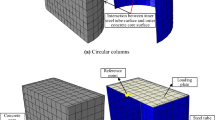Abstract
Double-skinned composite tubular (DSCT) columns consisting of concrete cast between outer and inner tubes have been developed to overcome certain limitations of other columns, such as the large self-weight of concrete-filled tubular columns and lack of concrete confinement of hollow concrete-filled tubular columns. The strength and ductility of the column are enhanced by the continuous confining stress provided by the inner tube. Their excellent structural performances make them particularly suitable for applications in high-rise buildings. However, if a high-rise building is damaged by fire, the economic costs associated with building repair can be high. It is very important to put the fire-damaged building back into service with the minimum post-fire repair. Thus, to predict the status of a structure under fire, its behavior should be evaluated based on the fire duration. Studies on the fire resistance of DSCT columns have been carried out for this purpose. However, they have involved the performance of the entire system without considering the effects of the DSCT column’s components on the fire resistance. In this paper, the behavior of a DSCT column is investigated under an ISO-834 standard fire using an analytical method. The evaluation method for the fire resistance of a DSCT column utilizes a thermal analysis and Eurocode. In addition, the relationship between the DSCT column’s components and the fire resistance is investigated, considering the confining effect. Moreover, the behavior of the DSCT column is evaluated through parametric studies of the hollow ratio, thickness of the outer tube, and thickness of the inner tube.















Similar content being viewed by others
References
Shakir-Khalil H, Illouli S (1987) Composite columns of concentric steel tubes. In: Proceeding of conference on the design and construction of non conventional structures, pp 73–82
Han TH, Stallings JM, Kang YJ (2010) Nonlinear concrete model for double-skinned composite tubular columns. Constr Build Mater 24(12):2542–2553
Yang F, Han LH (2008) Concrete-filled double-skin tubular columns under fire. Mag Concr Res 60(3):211–222
Han LH, Zhao XL, Yang YF, Feng JB (2003) Experimental study and calculation of fire resistance of concrete-filled hollow steel columns. J Struct Eng ASCE 129(3):346–356
Lu H, Zhao XL, Han LH (2010) Testing of self-consolidating concrete-filled double skin tubular stub columns exposed to fire. J Constr Steel Res 66(8):1069–1080
Lu H, Han LH, Zhao XL (2010) Fire performance of self-consolidating concrete filled double skin steel tubular columns: experiments. Fire Saf J 45:106–115
Lu H, Zhao X-L, Han LH (2011) FE modelling and fire resistance design of concrete filled double skin tubular columns. J Constr Steel Res 67(11):1733–1748
Park SH, Song KC, Chung SK, Min BY, Choi SM (2009) An experimental study on the fire resistance of concrete-filled double skin tubular columns. The 5th international symposium on steel structures, pp 299–307
Pires TAC, Rodrigues JPC, Rego Silva JJ (2012) Fire resistance of concrete filled circular hollow columns with restrained thermal elongation. J Struct Steel Res 77:82–94
Romero ML, Espinos A, Portoles JM, Hospitaler A, Ibanez C (2014) Concrete filled circular double-tube steel columns subjected to fire. 8th International Conferences on Structures in Fire—SiF’14, Shanghai, China, pp 769–776
ISO 834 (1999) Fire Resistance tests—elements of building construction
Eurocode 2, Design of concrete structures—Part 1.2: General rules—Structural fire design
Eurocode 3, Design of steel structures—Part 1–2: General rules—Structural fire design, EN 1993-1-2
SIMULIA (2010) ABAQUS Manual 6.9.1
Mander JB, Priestley MJN, Park R (1984) Seismic design of bridge piers. Research report no. 84-2, University of Canterbury, New Zealand
Popovics S (1973) A numerical approach to the complete stress–strain curves of concrete. Cem Concr Res 3(5):583–599
Han TH, Won DH, Kim SJ, Kang YJ (2013) Performance of a double-skinned composite tubular column under lateral loading: analysis. Mag Concr Res 65(2):121–135
Kilpatrick AE, Ranagan BV (1997) Deformation-control analysis of composite concrete columns. Research Report no. 3/97. School of Civil Engineering, Curtin University of Technology, Perth, Western Australia
Acknowledgments
This research was supported by a Grant (code 12 Technology Innovation E09) from the Construction Technology Innovation Program funded by the Ministry of Land, Transportation Affairs (MLTM) of the Korean government and Korea Institute of Ocean Science & Technology (KIOST), Project No. PE99321.
Author information
Authors and Affiliations
Corresponding author
Rights and permissions
About this article
Cite this article
Won, D.H., Han, T.H., Kim, S. et al. Fire resistance of double-skinned composite tubular columns including concrete confinement. Mater Struct 49, 1269–1284 (2016). https://doi.org/10.1617/s11527-015-0575-9
Received:
Accepted:
Published:
Issue Date:
DOI: https://doi.org/10.1617/s11527-015-0575-9




